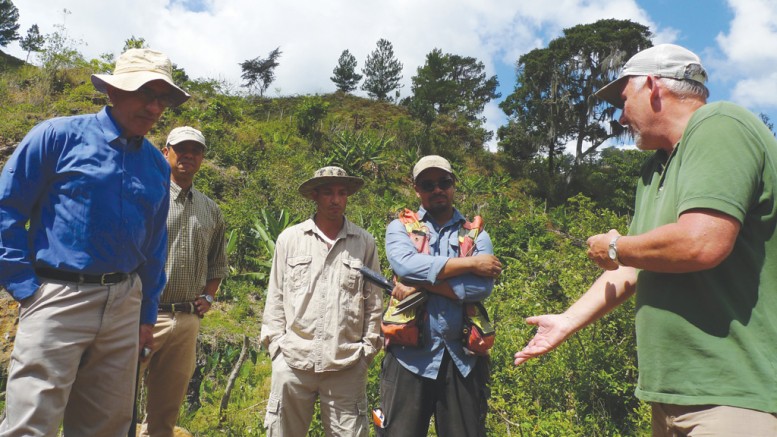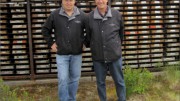SAN JUAN, DOMINICAN REPUBLIC — The road to GoldQuest Mining’s (TSXV: GQC) exploration camp is rough to say the least. But president and CEO Julio Espaillat’s hands are steady on the wheel as he navigates the sharp turns, dips and rises. Clearly comfortable in this remote part of his native Dominican Republic, he waves and greets everyone he sees along the dirt road to the camp.
Romero is 165 km northwest of the capital Santo Domingo, in the mountainous and fertile San Juan River valley, known for growing most of the nation’s bean crop. Relatively poor, the region is cut off from the Dominican Republic’s more developed areas and inland from its world-class beaches.
The camp is 35 km north of the provincial capital of San Juan de la Maguana, a city of 200,000 people. Paved roads cover most of the way to the project, but the final 16 km take well over an hour to pass.
The border with Haiti is 40 km from Romero. Espaillat points out some of the farmers on muleback along the way are French-speaking migrants, while we, his passengers, tighten our grips to avoid bumping our heads as we trundle over an upgraded mule path that takes us from 1,000 to 1,700 metres above sealevel — including a 650-metre climb over a 2 km stretch — before dipping down to 1,100 metres to arrive at camp.

The tilled field to the left of the river is a potential portal location at the Romero gold-copper project. Photo by David Perri.
When GoldQuest first arrived here they took this road as far as they could and set up camp beside the 80-person village of Hondo Vallee in 2005.
Traditional bootstrap geology led to the company’s first discovery in 2006, just 1 km from the camp: the outcropping Romero South gold deposit (formerly named Escandalosa).
They wouldn’t know for another six years, but the explorers had set up camp right on top of the tail end of something significant: Romero proper, a much larger gold-copper deposit that is GoldQuest’s flagship asset today.
With little in the way of surface showings, Romero was uncovered in 2012 after the company drilled 15 holes into induced-polarization (IP) chargeability high anomalies and pulled up the discovery hole just 700 metres from the camp. As far as discovery holes go, it left little doubt with a true width intercept of 231 metres grading 2.4 grams gold per tonne and 0.4% copper.
Bill Fisher, GoldQuest’s executive chairman, speaks proudly of the deposit discovered shortly after he joined the company, as he leads analysts and journalists on a tour of the property. “Romero has delivered the best hole ever drilled in the Caribbean.”
He’s referring to the third hole drilled after the discovery, which returned 235 metres of 4.7 grams gold and 1.4% copper.
Fisher’s eyes light up when he talks about the Romero orebody, the core of which sits 150 metres below surface. “The middle of it is beautifully rich.”
“We’ve really caught the trunk of the deposit,” Fisher says, noting that it has been drilled off to low grade in all directions — not zero. “How far do the branches go? We may be lucky. But the trunk is the key here — the gold-copper trunk.”

GoldQuest Mining executive chairman Bill Fisher (left) points to a possible mill site at the Romero project in the Dominican Republic, as engineering manager Jean Pierre Leblanc (middle) and president and CEO Julio Espaillat, look on. Photo by David Perri.
The full deposit runs 1 km along strike, but its rich core, which contains half of the mineral wealth, spans 350 metres along strike length, 150 metres wide and 250 metres thick.
Romero is an epithermal volcanogenic massive sulphide deposit with mineralization associated with pyrite, chalcopyrite and sphalerite. It’s situated in the tectonic Tireo belt, which was formed by a series of volcanic flows in the Cretaceous period.
In 2013, GoldQuest outlined a National Instrument 43-101 compliant resource estimate for Romero of 17.3 million indicated tonnes grading 2.55 grams gold per tonne and 0.7% copper, which adds up to 2.1 million equivalent oz. gold. Another 8.5 million inferred tonnes grade 1.59 grams gold and 0.4% copper for another 678,000 equivalent oz. gold.
GoldQuest released a preliminary economic assessment (PEA) in July 2014, with an optimized study tabled in June 2015. That latest study, completed by JDS Energy & Mining, forms the basis for the upcoming Romero prefeasibility study.
“This is the decision point,” Fisher says of the prefeasibility study’s rigorous nature. “Prefeasibility is the most exciting and scariest time of any project, because you can’t hide.”
The junior had planned to table the study in May 2016, but that month it announced it had switched from Met-Chem to JDS to finish the job by September 2016.
“We decided to revert to the simple JDS plan, as outlined in the JDS PEA, as opposed to a larger project, which is where the Met-Chem work was heading,” vice-president of exploration Jeremy Niemi explains. “We decided to give JDS the opportunity to complete their PEA concept, using much of the valuable work done by Met-Chem.”
Niemi says the prefeasibility study will deliver a refined version of JDS’s PEA plan, which envisioned Romero as the Dominican Republic’s first underground mine. Preproduction costs were pegged at US$143 million, plus US$92 million in sustaining costs over a nine-year mine life, operating at a 2,500 tonnes per day to produce 117,000 equivalent oz. gold per year in a gold-copper concentrate.
With all in sustaining costs of US$572 per equivalent oz. gold, the study judged that the project had a US$355-million pre-tax net present value (US$219 million after tax), with a pre-tax 46% internal rate of return (34% after tax).
Niemi says that the firm will publish reserves in the coming prefeasibility study. “With this relatively compact, well-behaved mineralization style, we didn’t have to drill it like you would have to drill a narrow vein system,” he says. “The drill spacing is 35 metres, which gets you to an indicated resource.”
“Last year we drilled only six holes — a total of 2,000 metres — and we converted all of the inferred material that was in our PEA to indicated, so that it could be contemplated as a reserve in the upcoming study.”
Beyond Romero
Romero sits in the Tireo belt, much of which is unexplored.
“We’re big believers that this is a mineral belt, and we have about a 50 km strike length piece of that belt,” Niemi says.
In the years since the Romero discovery, with the gold price oftentimes depressed and cash hard to come by, GoldQuest has kept exploring on its concessions, while stretching its cash as far as possible.
In 2014 the company flew an airborne geophysical survey over the property, totalling more than 3,000 line km of helicopter-based magnetic and electromagnetic surveying.
Then GoldQuest geologists moved on to low-cost “boots-on-the-ground” exploration, including detailed geological mapping of lithology, alteration and mineralogy on prospective areas that sit in magnetic lows.
“We’ve mapped nearly 20 km of the strike length, moving southwards,” Niemi says. “I’d say more than a dozen drill targets have come out of that.”
Once its geologists identified the most prospective areas, the company ordered a ground IP program to refine potential targets.

GoldQuest Mining president and CEO Julio Espaillat navigates past a farmer on the road to the Romero copper-gold project in the Dominican Republic. Photo by David Perri.
With the market on an uptick this year, GoldQuest finds itself with more than $9 million in hand after a pair of spring financings. The firm has signed a contract with Energold Drilling (CVE: EGD) and is kicking off a campaign in August that will see 40 holes drilled to 250 metres depth (10,000 metres total) into the targets it has cultivated during the market lull.
“We’re going after low-hanging fruit, near-surface mineralization — not deep drilling — and looking to prove that this is in fact a mineral belt with multiple deposits.”
Niemi says the company is mostly chasing Romero-type deposits, but geologists have found quartz-barite material, with sulphide minerals that are 400 metres apart. The best sample contains 167 grams gold per tonne, more than 300 grams silver — the upper detection limit — 2.2% copper and 5.2% zinc. He suspects this could indicate a narrower target and a structural feature, and he anticipates finding more such occurrences.
This sample is from the Loma el Cachimbo area, which Niemi says is one of the property’s best targets, with all the right ingredients to host a Romero-style deposit.
“The targets are strong IP chargeability anomalies well over 1 km in length, and hundreds of metres wide,” Niemi says. “There is the potential for large volumes of mineralized rock. And high-grade gold in surface samples makes these particularly compelling.”
Around Tireo
GoldQuest is easily the biggest player in the Tireo belt, but it is not alone. After the Romero discovery in 2012, Precipitate Gold (CVE: PRG) arrived on the scene and has since amassed a land position that largely abuts GoldQuest’s to the southwest. In September 2014, Precipitate announced it hit a discovery hole at Ginger Ridge, 25 km south of Romero, near the Loma el Cachimbo area. The hole returned 18 metres grading 4.5 grams gold per tonne, including 13.4 grams over 5 metres.
In September 2015, the neighbouring juniors put their heads together and signed a collaborative exploration and data-sharing agreement. In March 2016 Precipitate appointed Alistair Waddell to its board. Waddell is a GoldQuest founder who served as its president and CEO from 2007 to 2010.
About 45 km west–northwest along strike from Romero is Unigold’s (TSXV: UGD) Neita gold project. In February 2015 it released an inferred resource estimate of 5.3 million tonnes grading 5.3 grams gold and 0.4% copper for 894,000 oz. and 41.1 million lb. copper.
The road ahead
There’s a lot of work for GoldQuest in the Tireo belt. The firm benefits from having an experienced team that’s done it all before in the Dominican Republic. President and CEO Espaillat served as vice-president of exploration at GlobeStar Mining, which developed the Cerro de Maimon copper-gold mine in the centre of the country. Executive chairman Fisher was CEO of GlobeStar, which was acquired by Perilya (ASX: PEM) in 2008 for $186 million.
Moreover, in 2015 the company appointed Jean Pierre Leblanc as engineering manager. Leblanc was project manager during the construction and startup of Cerro de Maimon. One of Leblanc’s main tasks has to oversee the design and permit application for an upgraded access road to move heavy mining equipment in, and truckloads of copper concentrate out.
GoldQuest expects to have a finished Romero prefeasibility study and fresh exploration drill results in time for conference season later this year. In June it hired Red Cloud Klondike Strike to help with investor relations.
In terms of permitting at Romero, the company is working to complete its environmental-impact assessment, and expects to have a 25-year mining exploitation licence in hand soon.
At press time GoldQuest shares traded for 66¢ apiece, within a 52-week price range of 9¢ to 68¢. The firm has 213.6 million shares outstanding and a $141-million market capitalization. It counts mining mogul Rob McEwen and Warren Irwin’s Rousseau Asset Management as major shareholders.






Be the first to comment on "Site visit: GoldQuest’s Romero at ‘decision point’"